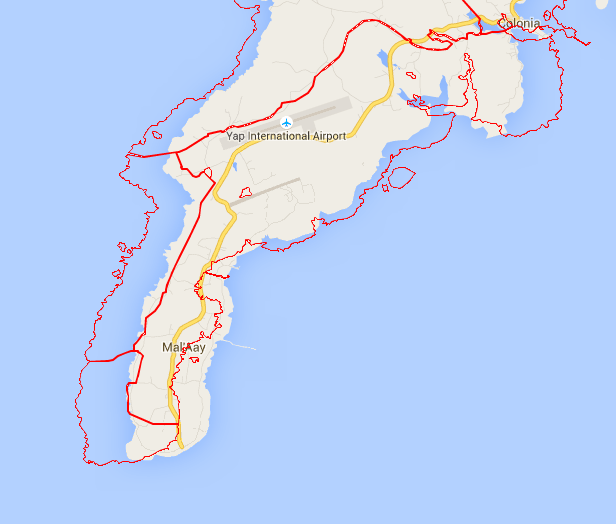In answer to the original request
Just in case you can't access QGIS, I've created three separate shapefiles and put them on dropbox. The projection of these shapefiles is EPSG:4326
https://dl.dropboxusercontent.com/u/71658964/miconesia.zip
Another dataset you may also be interested in is the WMS service GSJ CCOP Combined Bedrock and Superficial Geology and Age
To assist with the follow-up question/issues
I used ogrinfo on the original file and it tells me the projection is EPSG:4326, I think, for example:
ogrinfo -so FSM_adm_SBOC_PCRAFI.gdb state
Had to open data source read-only.
INFO: Open of `FSM_adm_SBOC_PCRAFI.gdb'
using driver `OpenFileGDB' successful.
Layer name: State
Geometry: Multi Polygon
Feature Count: 4
Extent: (137.491872, 1.022685) - (163.051392, 10.036174)
Layer SRS WKT:
GEOGCS["GCS_WGS_1984",
DATUM["WGS_1984",
SPHEROID["WGS_84",6378137.0,298.257223563]],
PRIMEM["Greenwich",0.0],
UNIT["Degree",0.0174532925199433]]
FID Column = OBJECTID
Geometry Column = Shape
SID: Real (0.0)
State: String (0.0)
Census_00: Real (0.0)
Proj_10: Real (0.0)
Shape_Length: Real (0.0)
Shape_Area: Real (0.0)
Looking at your backdrop, I can see it has come from Google Maps. So you will probably want to convert the shapefiles to EPSG:3857 - WGS84 / Pseudo Mercator, or just save the file geodatabase to a shapefile in that CRS.
It is possible though that the original data is not in EPSG:4326 (WGS 84), it might be worth looking at projections using earlier geodetic systems.
The YAP STATE CODE tells us for instance:
The Yap Islands coordinate system is hereby defined as a modified azimuthal equal distance projection in which the geodetic origin and the geodetic distance and the grid azimuth coincide at the point of origin and the geodetic distance and the grid distance are the same between the point of origin and any other point of the projection. This projection is based on the Clark Spheroid of 1866 and the 1965 Guam Datum. The point or origin of the system is station "YAP SECOR AMS 1965", having assigned to it the coordinates NORTH 60,000.00 meters, and EAST 40,000.00 meters. The geodetic position of "YAP SECOR" is 9 degrees 32 minutes 48.15 seconds NORTH latitude and 138 degrees 10 minutes 7.48 seconds EAST longitude. The basis of this coordinate system shall be the survey network established by the Army Map Service 1965 and extended by the U.S. Geological Survey in 1970.
 it is currently 4326
it is currently 4326